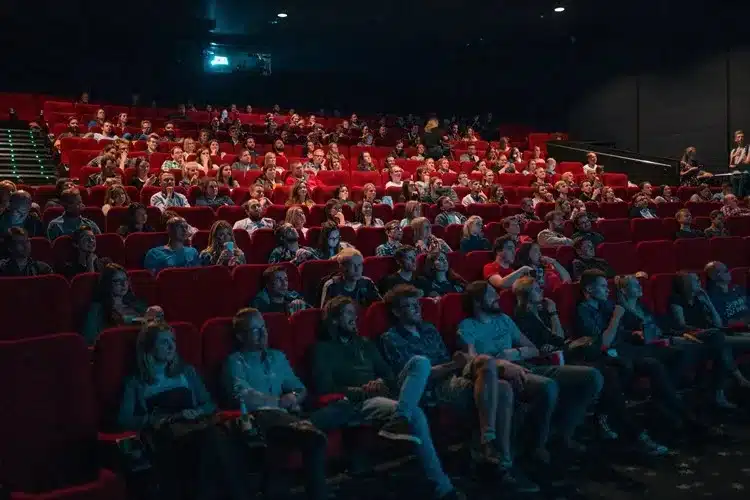The presence of volatile organic compounds (VOC) and CO2 in cinema may help classification of movie | Image Source: Krists Luhaers on Unsplash
The 2021 Ig Nobel Chemistry Prize is awarded to a team of researchers (Jörg Wicker, Nicolas Krauter, Bettina Derstroff, Christof Stönner, Efstratios Bourtsoukidis, Achim Edtbauer, Jochen Wulf, Thomas Klüpfel, Stefan Kramer, and Jonathan Williams) for chemically analyzing the air inside movie theatres, to test whether the odors produced by an audience reliably indicate the levels of violence, sex, antisocial behavior, drug use, and bad language in the movie the audience is watching.
How are movies for the public audiences are rated? There are obvious reasons: to protect the children from unnecessary exposure to violence and sexual content. There are different approaches in various countries. Germany uses 0, 6, 12, 16, 18, while the United States has G (general audiences), PG (parental guidance suggested), PG-13 (Parents strongly cautioned), R (restricted), and NC-17 (no one 17 and under admitted). India the world´s most prolific filmmaker, uses U (0 to 11), UA (to 17), and A for adults.
Classification of movies is mostly a complicated affair and is guided by numerous parameters like the presence of sexual content, degree of violence, bad language. Also, these parameters are subjective and contentious issues because measuring parameters keep changing as the guidelines evolve with time.
In order to trim the subjective issue in measuring the presence of sexual content, degree of violence, bad language in movies, the study is carried out to estimate the content of same using chemically analyzing the air inside movie theatres, to test whether the odors produced by an audience reliably indicate the levels of violence, sex, antisocial behavior, drug use, and bad language in the movie the audience is watching. The study studied the presence of volatile organic compounds (VOC) and CO2 in cinema air.
The 2021 Ig Nobel Prizes were awarded at the 31st First Annual Ig Nobel Prize ceremony, on Thursday, September 9, 2021. The event honours the achievements that make people laugh, then think. The prizes are intended to celebrate the unusual, honour the imaginative — and spur people’s interest in science, medicine, and technology.
Most of the new winners will give free public talks to explain if they can, what they did and why they did it. These talks, the Ig Informal Lectures, will be presented one at a time, over the coming weeks. Because of the Covid-19 pandemic, this year’s lectures will be presented online, here at www.improbable.com, rather than in a lecture hall in their usual home, MIT (the Massachusetts Institute of Technology).
The 2021 Ig Nobel Prize winners
Biology Prize: Susanne Schötz for analyzing variations in purring, chirping, chattering, trilling, tweedling, murmuring, meowing, moaning, squeaking, hissing, yowling, howling, growling, and other modes of cat-human communication. Study reference: A Comparative Acoustic Analysis of Purring in Four Cats
Ecology Prize: Leila Satari, Alba Guillén, Àngela Vidal-Verdú, and Manuel Porcar, for using genetic analysis to identify the different species of bacteria that reside in wads of discarded chewing gum stuck on pavements in various countries. Study reference: The Wasted Chewing Gum Bacteriome
Economics Prize: Pavlo Blavatskyy, for discovering that the obesity of a country’s politicians may be a good indicator of that country’s corruption.
Study reference: Obesity of Politicians and Corruption in Post‐Soviet Countries
Medicine Prize: Olcay Cem Bulut, Dare Oladokun, Burkard Lippert, and Ralph Hohenberger, for demonstrating that sexual orgasms can be as effective as decongestant medicines at improving nasal breathing.
Study reference: Can Sex Improve Nasal Function? — An Exploration of the Link Between Sex and Nasal Function
Peace Prize: Ethan Beseris, Steven Naleway, and David Carrier, for testing the hypothesis that humans evolved beards to protect themselves from punches to the face.
REFERENCE: Impact Protection Potential of Mammalian Hair: Testing the Pugilism Hypothesis for the Evolution of Human Facial Hai
Physics Prize: Alessandro Corbetta, Jasper Meeusen, Chung-min Lee, Roberto Benzi, and Federico Toschi, for conducting experiments to learn why pedestrians do not constantly collide with other pedestrians.
Study reference: Physics-based modelling and data representation of pairwise interactions among pedestrians
Kinetics Prize: Hisashi Murakami, Claudio Feliciani, Yuta Nishiyama, and Katsuhiro Nishinari, for conducting experiments to learn why pedestrians do sometimes collide with other pedestrians.
Study reference: Mutual Anticipation Can Contribute to Self-Organization in Human Crowds
Entomology Prize: John Mulrennan, Jr., Roger Grothaus, Charles Hammond, and Jay Lamdin, for their research study “A New Method of Cockroach Control on Submarines”. Study reference: A New Method of Cockroach Control on Submarines
Transportation Prize: Robin Radcliffe, Mark Jago, Peter Morkel, Estelle Morkel, Pierre du Preez, Piet Beytell, Birgit Kotting, Bakker Manuel, Jan Hendrik du Preez, Michele Miller, Julia Felippe, Stephen Parry, and Robin Gleed, for determining by experiment whether it is safer to transport an airborne rhinoceros upside-down. Study reference: The Pulmonary and Metabolic Effects of Suspension by the Feet Compared with Lateral Recumbency in Immobilized Black Rhinoceroses (Diceros bicornis) Captured by Aerial Dartin

